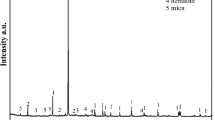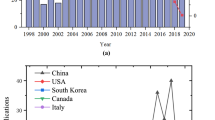Abstract
Pb and Zn contamination in agricultural soils has become an important issue for human health and the environment. Washing is an effective method for remediating polluted soil. Here, we compare several washing materials and methods in the treatment of Pb- and Zn-polluted farmland soil. We examined four washing reagents, hydrochloric acid, citric acid, Na2EDTA, and tartaric acid, all of which independently removed Zn at rates >65 %. Combining washing reagents markedly enhanced heavy metal removal, by using Na2EDTA and either tartaric acid or lactate in sequence: Pb and Zn removal rates improved to 84.1 and 82.1 % for Na2EDTA-tartaric acid; and to 88.3 and 89.9 % for Na2EDTA-lactate, respectively. Additionally, combining ultrasound with conventional washing methods markedly improved washing efficiency, by shortening washing duration by 96 %. We achieved similar removal rates using ultrasound for 10 min, compared with traditional mechanical vibration alone for 4 h. We concluded that treating Pb- and Zn-contaminated soil with appropriate washing reagents under optimal conditions can greatly enhance the remediation of polluted farmland soils.





Similar content being viewed by others
References
Covelo EF, Vega FA, Andrade ML (2007) Simultaneous sorption and desorption of Cd, Cr, Cu, Ni, Pb, and Zn in acid soils. J Hazard Mater 147:862–870
Dermont G, Bergeron M, Mercier G, Richer-Laflèche M (2008) Soil washing for metal removal: a review of physical/chemical technologies and field applications. J Hazard Mater 152:1–31
Di Palma L, Mecozzi R (2007) Heavy metals mobilization from harbour sediments using EDTA and citric acid as chelating agents. J Hazard Mater 147:768–775
Elbeshbishy E, Hafez H, Nakhla G (2011a) Ultrasonication for biohydrogen production from food waste. Int J Hydrogen Energy 36:2896–2903
Elbeshbishy E, Hafez H, Dhar BR, Nakhla G (2011b) Single and combined effect of various pretreatment methods for biohydrogen production from food waste. Int J Hydrogen Energ 36:11379–11387
Golan T, Dahan G, Ludmer Z, Brauner N, Ullmann A (2014) Heavy metals extraction with the SRPTE process from two matrices – industrial sludge and river sediments. Chem Eng J 236:47–58
Gusiatin ZM, Klimiuk E (2012) Metal (Cu, Cd and Zn) removal and stabilization during multiple soil washing by saponin. Chemosphere 86:383–391
He Z, Siripornadulsil S, Sayre RT, Traina SJ, Weavers LK (2011) Removal of mercury from sediment by ultrasound combined with biomass (transgenic Chlamydomonas reinhardtii). Chemosphere 83:1249–1254
Jiang J, Gong C, Wang J, Tian S, Zhang Y (2014) Effects of ultrasound pre-treatment on the amount of dissolved organic matter extracted from food waste. Bioresource Technol 155:266–271
Jung Y, Ko H, Jung B, Sung N (2011) Application of ultrasonic system for enhanced sewage sludge disintegration: A comparative study of single- and dual- frequency. KSCE J Civ Eng 15:793–797
Kim D, Hwang B, Moon D, Kim Y, Baek K (2013) Environmental assessment on a soil washing process of a Pb-contaminated shooting range site: a case study. Environ Sci Pollut Res 20:8417–8424
Li Y, Hu X, Song X, Sun T (2012) Remediation of cadmium-contaminated soil by extraction with para-sulphonato-thiacalix[4]arene, a novel supramolecular receptor. Environ Pollut 167:93–100
Li Y, Hu P, Zhao J, Dong C (2015) Remediation of cadmium- and lead-contaminated agricultural soil by composite washing with chlorides and citric acid. Environ Sci Pollut Res 22:5563–5571
Maity JP, Huang YM, Hsu C, Wu C, Chen C, Li C, Jean J, Chang Y, Chen C (2013) Removal of Cu, Pb and Zn by foam fractionation and a soil washing process from contaminated industrial soils using soapberry-derived saponin: a comparative effectiveness assessment. Chemosphere 92:1286–1293
Mao X, Jiang R, Xiao W, Yu J (2015) Use of surfactants for the remediation of contaminated soils: a review. J Hazard Mater 285:419–435
Moon DH, Lee J, Wazne M, Park J (2012) Assessment of soil washing for Zn contaminated soils using various washing solutions. J Ind Eng Chem 18:822–825
Mulligan CN, Yong RN, Gibbs BF (2001) Heavy metal removal from sediments by biosurfactants. J Hazard Mater 85:111–125
Navarro A, Martínez F (2010) The use of soil-flushing to remediate metal contamination in a smelting slag dumping area: column and pilot-scale experiments. Eng Geol 115:16–27
Pérez-Cid B, Lavilla I, Bendicho C (1999) Use of Ultrasonic energy for shortening the sequential extraction of metals from river sediments. Int J Environ Anal Chem 73:79–92
Peters RW (1999) Chelant extraction of heavy metals from contaminated soils. J Hazard Mater 66:151–210
Pichtel J, Vine B, Kuula-Vaisanen P, Niskanen P (2001) Lead extraction from soils as affected by lead chemical and mineral forms. Environ Eng Sci 18:91–98
Pociecha M, Lestan D (2010a) Electrochemical EDTA recycling with sacrificial Al anode for remediation of Pb contaminated soil. Environ Pollut 158:2710–2715
Pociecha M, Lestan D (2010b) Using electrocoagulation for metal and chelant separation from washing solution after EDTA leaching of Pb, Zn and Cd contaminated soil. J Hazard Mater 174:670–678
Qiu R, Zou Z, Zhao Z, Zhang W, Zhang T, Dong H, Wei X (2010) Removal of trace and major metals by soil washing with Na2EDTA and oxalate. J Soils Sediments 10:45–53
Rauret G, López-Sánchez JF, Sahuquillo A, Barahona E, Lachica M, Ure AM, Davidson CM, Gomez A, Lück D, Bacon J, Yli-Halla M, Muntau H, Quevauviller P (2000) Application of a modified BCR sequential extraction (three-step) procedure for the determination of extractable trace metal contents in a sewage sludge amended soil reference material (CRM 483), complemented by a three-year stability study of acetic acid and EDTA extractable metal content. J Environ Monitor 2:228–233
Son Y, Nam S, Ashokkumar M, Khim J (2012) Comparison of energy consumptions between ultrasonic, mechanical, and combined soil washing processes. Ultrason Sonochem 19:395–398
Torres LG, Lopez RB, Beltran M (2012) Removal of As, Cd, Cu, Ni, Pb, and Zn from a highly contaminated industrial soil using surfactant enhanced soil washing. Phys Chem Earth, Parts A/B/C 37–39:30–36
Tsang DCW, Lo IMC (2006) Competitive Cu and Cd sorption and transport in soils: a combined batch kinetics, column, and sequential extraction study. Environ Sci Technol 40:6655–6661
Tuin BJW, Tels M (1990) Removing heavy metals from contaminated clay soils by extraction with hydrochloric acid, edta or hypochlorite solutions. Environ Technol 11:1039–1052
Udovic M, Lestan D (2009) Pb, Zn and Cd mobility, availability and fractionation in aged soil remediated by EDTA leaching. Chemosphere 74:1367–1373
Voglar D, Lestan D (2012) Pilot-scale washing of metal contaminated garden soil using EDTA. J Hazard Mater 215–216:32–39
Wang S, Mulligan CN (2013) Effects of three low-molecular-weight organic acids (LMWOAs) and pH on the mobilization of arsenic and heavy metals (Cu, Pb, and Zn) from mine tailings. Environ Geochem Health 35:111–118
Wu Q, Cui Y, Li Q, Sun J (2015) Effective removal of heavy metals from industrial sludge with the aid of a biodegradable chelating ligand GLDA. J Hazard Mater 283:748–754
Yang Z, Zhang S, Liao Y, Li Q, Wu B, Wu R (2012) Remediation of heavy metal contamination in calcareous soil by washing with reagents: a column washing. Procedia Environ Sci 16:778–785
Zhang W, Huang H, Tan F, Wang H, Qiu R (2010) Influence of EDTA washing on the species and mobility of heavy metals residual in soils. J Hazard Mater 173:369–376
Acknowledgments
This work was financially supported by the Major Science and Technology Program for Water Pollution Control and Treatment (2015ZX07205-003).
Author information
Authors and Affiliations
Corresponding author
Additional information
Responsible editor: Zhihong Xu
Rights and permissions
About this article
Cite this article
Wang, J., Jiang, J., Li, D. et al. Removal of Pb and Zn from contaminated soil by different washing methods: the influence of reagents and ultrasound. Environ Sci Pollut Res 22, 20084–20091 (2015). https://doi.org/10.1007/s11356-015-5219-7
Received:
Accepted:
Published:
Issue Date:
DOI: https://doi.org/10.1007/s11356-015-5219-7




